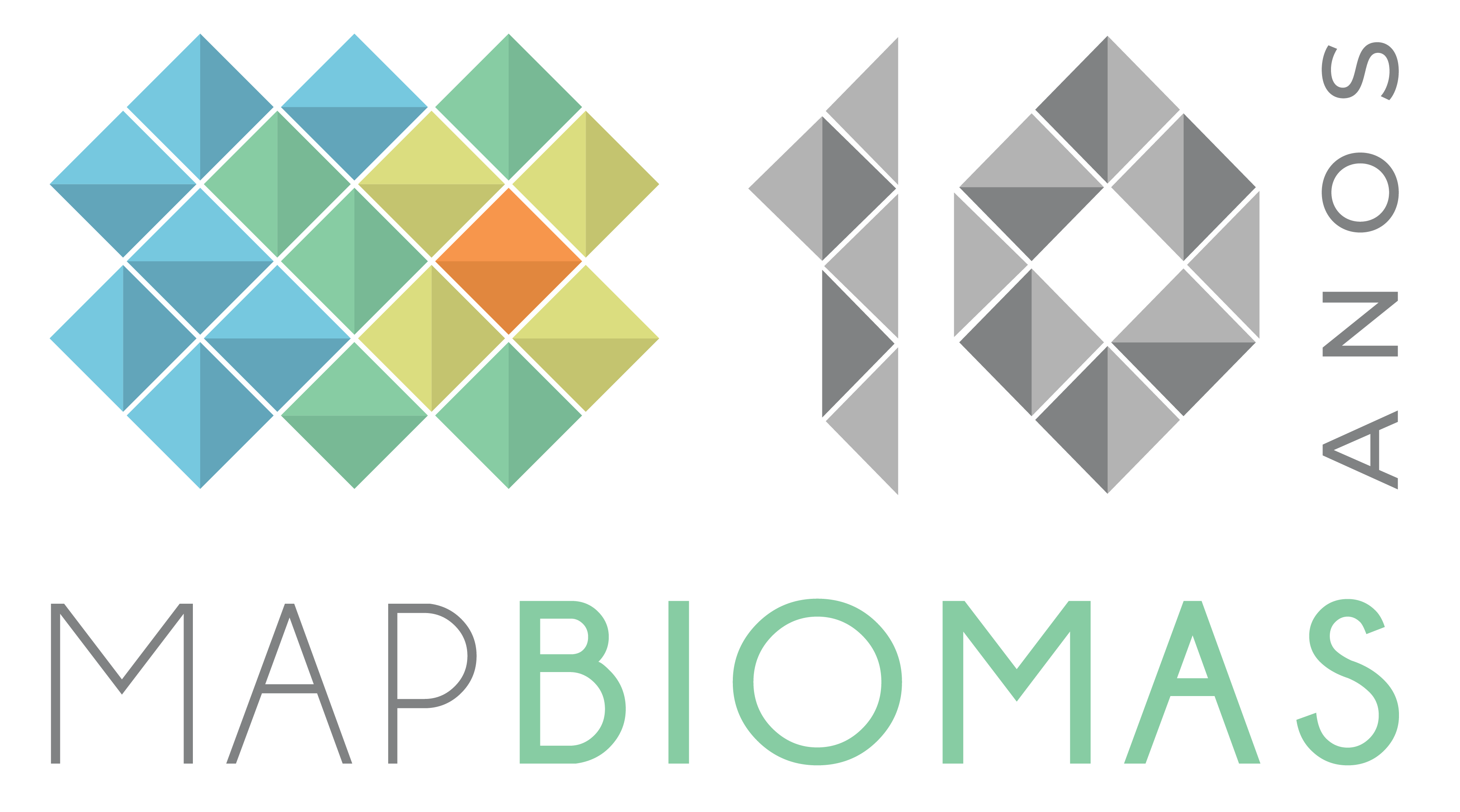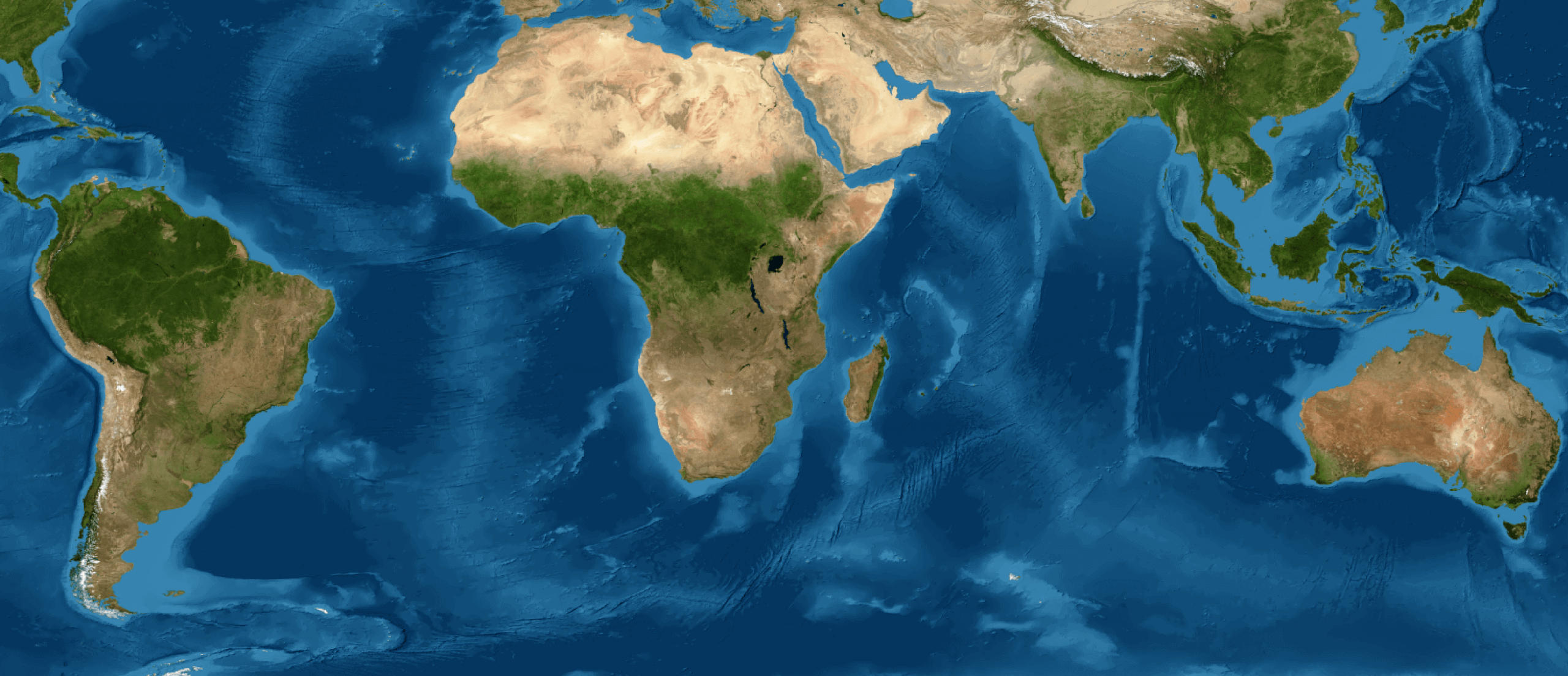Collection 2.1 of MapBiomas Soil presents annual maps of soil organic carbon stock in the 0-30 cm layer of Brazil, covering the period between 1985 and 2023 (beta version). Cross-referencing with land cover and land use data was done with Collection 9 of MapBiomas' annual land cover and land use maps of Brazil. The annual maps have a spatial resolution of 30 meters and the integer values are expressed in tons per hectare (t/ha).
In addition, Collection 2.1 of MapBiomas Soil includes static maps of sand, silt, and clay content for the 0-10, 10-20, 20-30, 0-20, and 0-30 cm layers, and soil texture for the 0-10, 0-20, and 0-30 cm layers (beta version). The static maps have a spatial resolution of 30 meters and those of particle size distribution have integer values expressed as percentages.
All products were developed using soil sample data published in the Brazilian Soil Data Repository (SoilData, https://soildata.mapbiomas.org/). For more details on the methods used, consult the methodological description and the ATBD on the MapBiomas website (https://brasil.mapbiomas.org/metodo-mapbiomas-solo/).
The data from the latest MapBiomas Soil collection can be accessed in four ways:
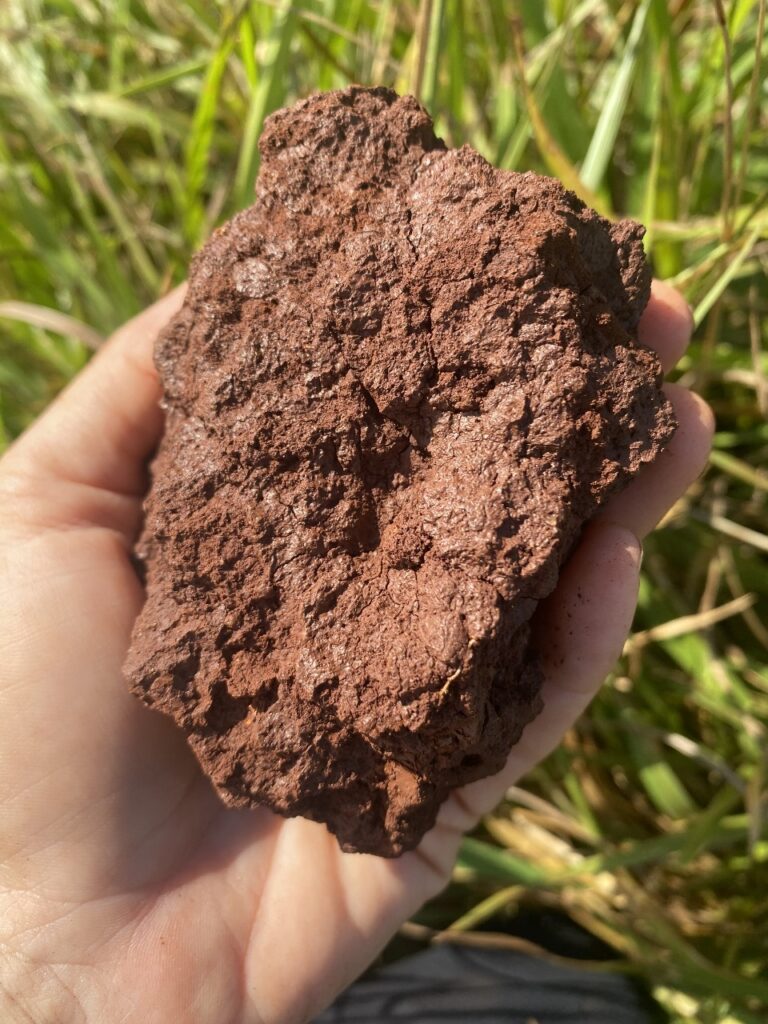
'1. SoilData Repository
Download the training data for the predictive models.
The SoilData Repository hosts the soil sample data used in training the predictive models for soil organic carbon stock and particle size distribution of MapBiomas Soil. The repository is publicly accessible and does not require account creation or login.
The repository offers data citation and visualization functionalities in addition to downloads in plain text format (TXT, CSV).
The training data for the predictive models can be accessed via the links:
- Organic carbon stock: https://doi.org/10.60502/SoilData/SXCSDK
- Particle size distribution: https://doi.org/10.60502/SoilData/P6R332
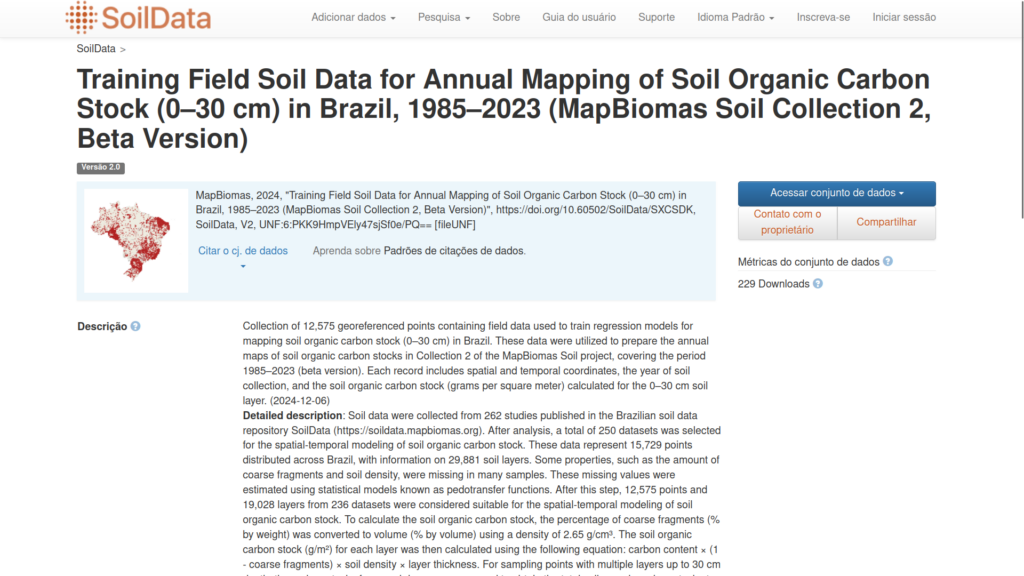
The SoilData Repository can be accessed via the following link: http://soildata.mapbiomas.org/.
'2. Online visualization and download platform
Explore MapBiomas Soil maps online and visualize geographic cutouts of your area of interest.
The MapBiomas platform allows visualizing maps of soil organic carbon stock, particle size distribution, and soil texture of Brazil. The platform is publicly accessible and does not require account creation or login, being the most user-friendly option and recommended for those seeking familiarity with the data and basic analyses.
The platform offers functionalities for online visualization of maps at different scales and geographic cutouts, years and soil depths, generation of graphs and tables with data from your area of interest, download of data in CSV format, and export of figures through screenshots.
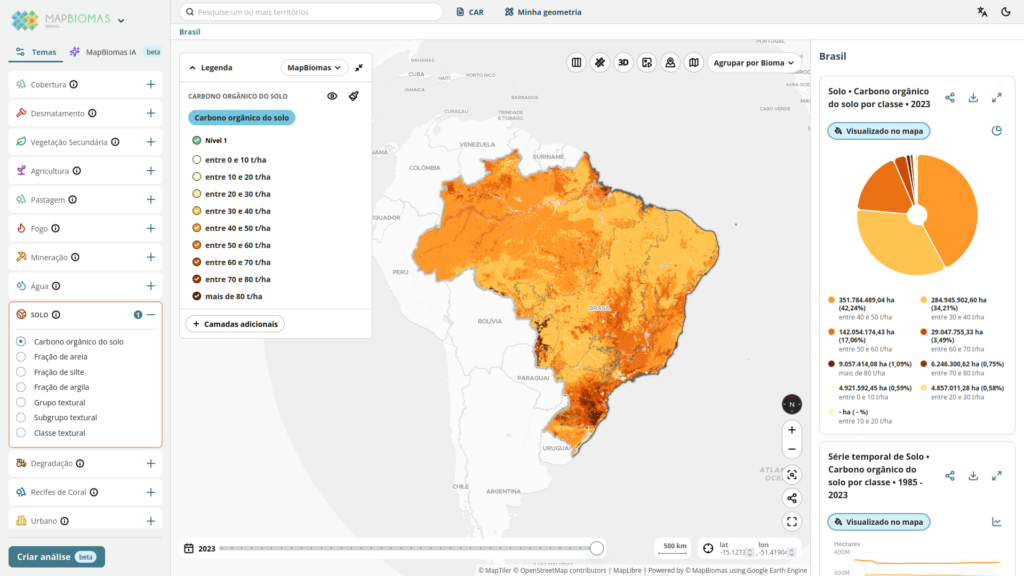
The MapBiomas platform can be accessed via the following link: https://plataforma.brasil.mapbiomas.org.
‘3. MapBiomas Soil Toolkit in Google Earth Engine
Export maps for selected geometries and periods.
The toolkit is a Google Earth Engine (GEE) script that allows exporting maps for selected geometries (spatial cutouts) and periods. This is an option for accessing maps recommended for those with little experience in geoprocessing and who need to download maps for spatial cutouts. The cutouts are downloaded to your Google Drive, where you must ensure sufficient storage space.
To use the MapBiomas Soil toolkit in GEE, you need to:
- Have a Google account. If you don't have one, you can create one for free at https://accounts.google.com/signup.
- Have a project in Google Cloud. If you don't have a project, you can create one for free at https://cloud.google.com/resource-manager/docs/creating-managing-projects
- Be registered with Google Earth Engine. If you haven't registered yet, you can do so for free at https://code.earthengine.google.com/register.
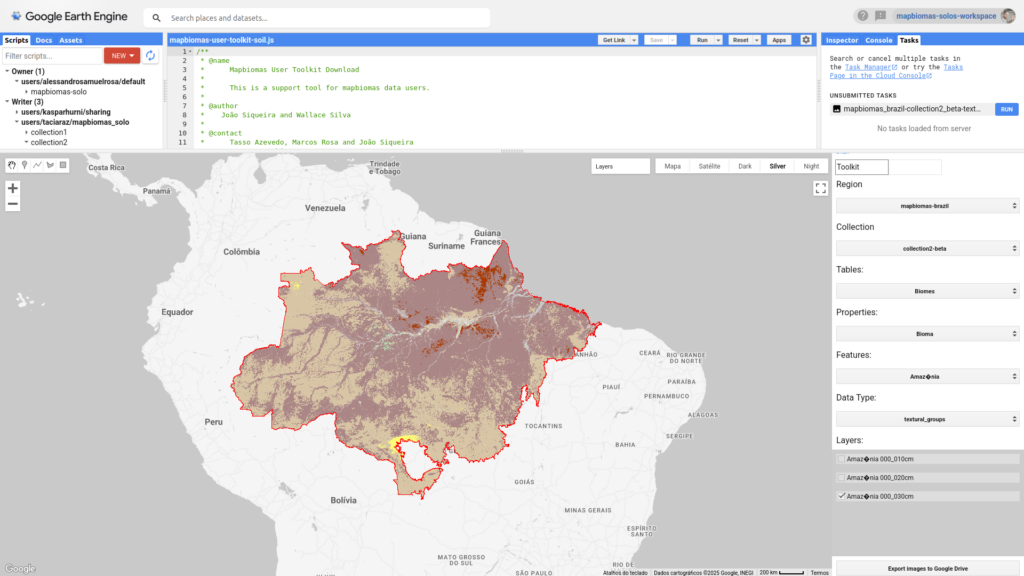
Once you have your Google account, your Google Cloud project, and GEE configured, you can access the MapBiomas Soil toolkit through this link:
To help you use the toolkit, we have prepared a video tutorial and an instruction manual:
- Tutorial video https://www.youtube.com/watch?v=OBqaoSuLGbk
- Instruction manual: https://github.com/mapbiomas/user-toolkit
4. MapBiomas Assets Directory in Google Earth Engine
Explore and use maps directly in GEE or via Python API.
MapBiomas Soil maps are also available in the public assets directory of the MapBiomas project in GEE. This option for accessing maps is recommended for users who wish to manipulate and use the data to perform analyses and modeling directly in GEE or via Python API, such as creating personalized maps and analyses by combining MapBiomas Soil data with other data available in GEE.
To use MapBiomas Soil maps in GEE, you need to have a Google account, a Google Cloud project, and be registered with GEE. If you don't have them yet, see the instructions in the MapBiomas Soil Toolkit in Google Earth Engine section.
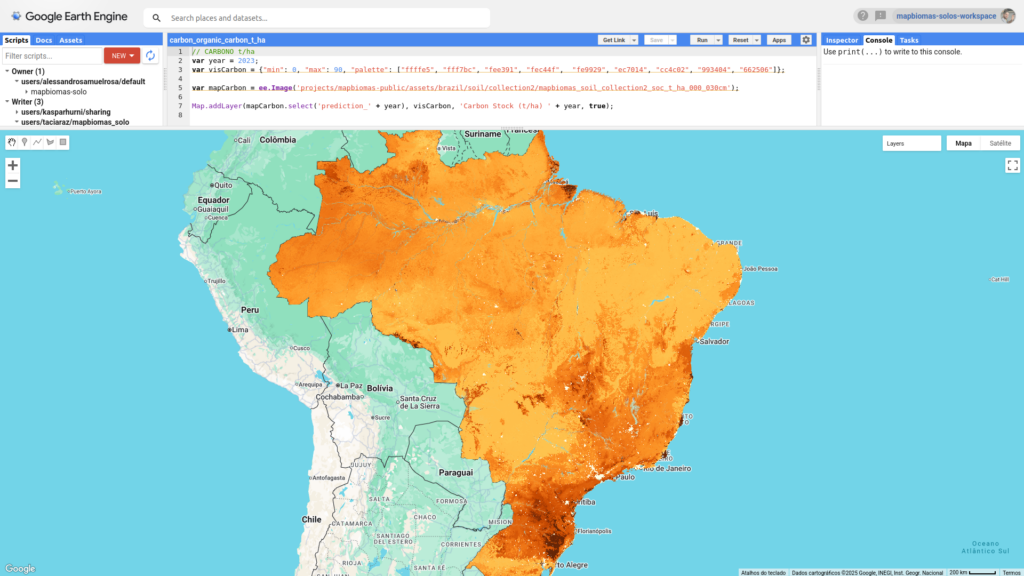
Access the complete list of public assets of MapBiomas Soil collections assets públicos das coleções do MapBiomas Solo here.
The address of the directory with MapBiomas Soil assets in GEE is: assets do MapBiomas Solo no GEE é:
- Collection 1 (beta): projects/mapbiomas-public/assets/brazil/soil/collection1/
- Collection 2.1 (beta): projects/mapbiomas-public/assets/brazil/soil/collection2_1/
The asset with the annual maps of soil organic carbon stock of Collection 2.1 (beta) is:
- mapbiomas_brazil_collection21_soil_carbon_v2 – organic carbon stock in the 0-30cm layer in t/ha.
This asset is a multiband image with 39 bands, where each band represents one of the years mapped between 1985 and 2023, named as follows:
- carbon_1985 – organic carbon stock in 1985;
- carbon_1986 – organic carbon stock in 1986;
- carbon_2023 – organic carbon stock in 2023;
Code examples:
In Collection 2.1 of MapBiomas Soil, the assets with the static maps of soil particle size distribution are: assets com os mapas estáticos de granulometria do solo são:
- mapbiomas_brazil_collection21_soil_clay_fraction_v2 – percentage of clay;
- mapbiomas_brazil_collection21_soil_silt_fraction_v2 – percentage of silt;
- mapbiomas_brazil_collection21_soil_sand_fraction_v2 – percentage of sand.
Each of these assets is a multiband image with five bands, where each band represents one of the mapped depth layers: 0-10, 10-20, 20-30, 0-20, and 0-30 cm. For example, for clay, the five bands are named as follows:
- clay_fraction_000_010_v2 – percentage of clay in the 0-10 cm layer;
- clay_fraction_010_020_v2 – percentage of clay in the 10-20 cm layer;
- clay_fraction_020_030_v2 – percentage of clay in the 20-30 cm layer;
- clay_fraction_000_020_v2 – percentage of clay in the 0-20 cm layer;
- clay_fraction_000_030_v2 – percentage of clay in the 0-30 cm layer.
Code examples:
- Clay content: https://code.earthengine.google.com/?scriptPath=users%2FmarcosrosaUSP%2FMapBiomas_col9_Geral%3Aexemplos_codigos_download%2Fgranulometry_clay
- Silt content: https://code.earthengine.google.com/?scriptPath=users%2FmarcosrosaUSP%2FMapBiomas_col9_Geral%3Aexemplos_codigos_download%2Fgranulometry_silt
- Sand content: https://code.earthengine.google.com/?scriptPath=users%2FmarcosrosaUSP%2FMapBiomas_col9_Geral%3Aexemplos_codigos_download%2Fgranulometry_sand
In MapBiomas Soil Collection 2.1, the assets with static soil texture maps are:
- mapbiomas_brazil_collection21_soil_textural_class_v2 – textural class (13 classes);
- mapbiomas_brazil_collection21_soil_textural_subgroup_v2 – textural subgrouping (8 classes);
- mapbiomas_brazil_collection21_soil_textural_group_v2 – textural grouping (5 classes).
Each of these assets is a multiband image with three bands, where each band represents one of the mapped depth layers: 0-10, 0-20, and 0-30 cm. For example, for the textural class map, the three bands are named as follows:
- textural_class_000_010_v2 – textural class of the 0-10 cm layer;
- textural_class_000_020_v2 – textural class of the 0-20 cm layer;
- textural_class_000_030_v2 – textural class of the 0-30 cm layer.
Code examples:
- Textural class: https://code.earthengine.google.com/?scriptPath=users%2FmarcosrosaUSP%2FMapBiomas_col9_Geral%3Aexemplos_codigos_download%2Ftextural_classes
- Textural subgrouping: https://code.earthengine.google.com/?scriptPath=users%2FmarcosrosaUSP%2FMapBiomas_col9_Geral%3Aexemplos_codigos_download%2Ftextural_subgroups
- Textural grouping: https://code.earthengine.google.com/?scriptPath=users%2FmarcosrosaUSP%2FMapBiomas_col9_Geral%3Aexemplos_codigos_download%2Ftextural_groups
MapBiomas data are public, open and free under Creative Commons CC-BY-SA license and by referencing the source observing the following format:
“MapBiomas - Collection[version] of the [Organic Carbon/Granulometry/Soil Texture] map series for Brazil, accessed on [date] via the link: [LINK]”
